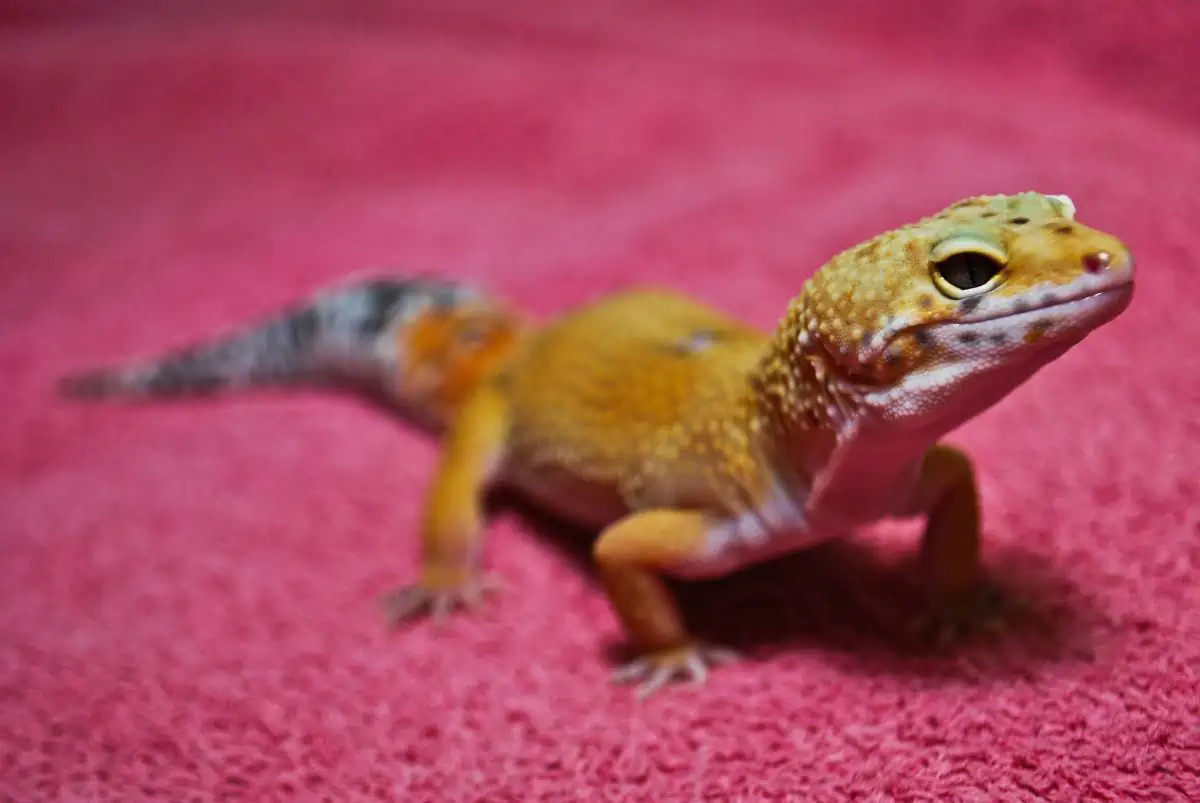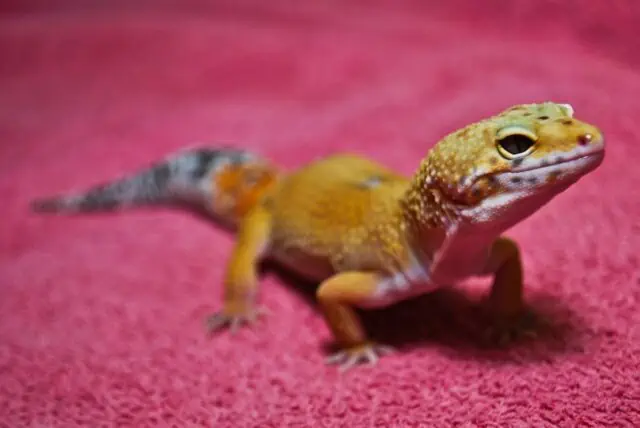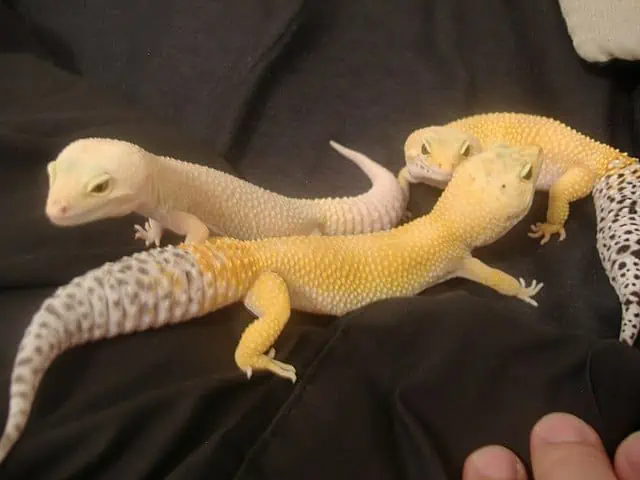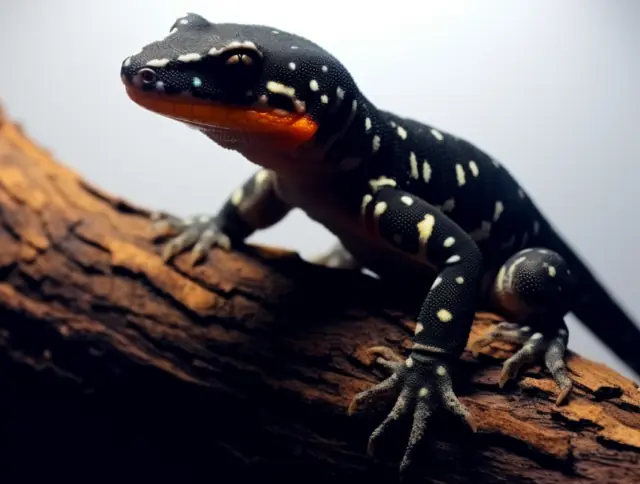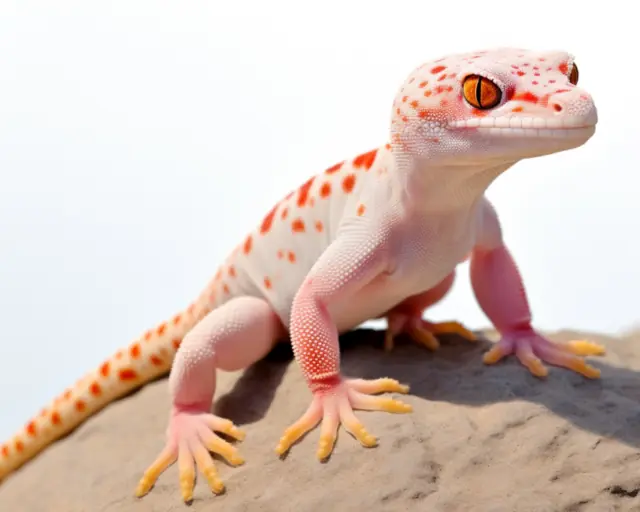Leopard geckos have firmly established their status as one of the most sought-after reptilian pets, gracing the terrariums of enthusiasts around the world. With their captivating patterns, friendly demeanor, and relatively low-maintenance care requirements, it’s no wonder they’re often the top pick for both novice and seasoned herpetologists.
However, beneath that vibrant exterior lies a complex anatomy that plays a pivotal role in their health and behavior. Understanding the intricacies of leopard gecko anatomy is not just a fascination; it’s an essential element for providing them with the optimal care they deserve.
Physical Appearance of Leopard Geckos
At first glance, the leopard gecko’s appearance is a symphony of patterns, colors, and textures that immediately captures one’s attention.
Their distinct physical features are not just aesthetically pleasing but also deeply rooted in their evolutionary history, reflecting adaptations that have ensured their survival in various habitats.
From the intricate patterns that adorn their skin to the unique feel of their scales, each aspect of their appearance has a story to tell.
Color Variations
One of the most intriguing aspects of leopard geckos is the extensive range of color morphs they exhibit. These morphs are essentially the various color and pattern combinations that these reptiles can have. Nature has already equipped them with a palette of colors to help them adapt and camouflage in their natural habitats. However, the world of leopard gecko breeding has taken these naturally occurring variations and expanded upon them, creating a dazzling array of morphs that can sometimes leave even seasoned herpetologists in awe.
There’s an interesting balance between what nature has designed and what selective breeding by humans has achieved. For instance, while natural morphs evolved over time for survival purposes like camouflage, many of the morphs we see in captivity today are a result of selective breeding. Breeders aim to achieve specific colors or patterns that might not necessarily occur in the wild but are highly sought after in the pet trade.
Key figures in the breeding world like Tremper, Bell, and Rainwater have contributed significantly to the development of various morphs. Specifically, their work with albinism in leopard geckos has led to the identification and categorization of different albino strains. The albino strains, often distinguished by their genetic variations, are especially captivating with their lack of dark pigments and uniquely colored eyes.
Furthermore, other genetic variations like the patternless morph present geckos that have a uniform color throughout, without the characteristic spots or bands. This kind of genetic deviation adds another dimension to the already vast spectrum of leopard gecko appearances.
Skin and Scales
Beyond the colors and patterns, the skin and scales of a leopard gecko are a marvel of evolutionary design. These components not only play a critical role in their daily lives and survival but also contribute to the tactile experience for those who handle them.
The process of shedding, or ecdysis, is a natural and fascinating phenomenon in leopard geckos. As they grow, their outer layer of skin becomes too tight, prompting the need to shed it to make way for a new, larger layer underneath. This shedding cycle is essential for the gecko’s growth and overall health. Observing a leopard gecko during its shedding phase can be both exciting and educational. They often become more reclusive, seeking out moist and secluded spots to aid in the removal of the old skin. Post-shed, they might even consume the shed skin, a behavior believed to help them reclaim vital nutrients.
When it comes to the feel of their skin, anyone who has had the pleasure of gently handling a leopard gecko will attest to its unique texture. Contrary to what one might expect from a reptile, their skin is not slimy. Instead, it’s soft yet granular, courtesy of the minute scales that cover their body. This distinct “Gecko skin feel” is unlike any other reptile, making the experience of handling them truly unique. As a downside, their skin is permeable, making it more susceptible to toxins.
The scale pattern on a leopard gecko is another testament to nature’s artistry. Each scale, while tiny, plays a part in the overall appearance of the gecko. The arrangement, size, and shape of these scales contribute to the gecko’s characteristic texture and play a role in their adaptability to different environments.
Leopard Gecko Internal Anatomy
While the exterior of the leopard gecko is undoubtedly a spectacle of colors, patterns, and textures, it’s within their internal makeup that we find the true essence of their existence. The internal anatomy of a leopard gecko is a complex system of organs and structures, each playing a pivotal role in their survival, health, and overall behavior. From the delicate processes that drive their digestion to the intricate workings of their reproductive systems, every component is finely tuned to ensure they thrive in their environment, whether in the wild or in captivity. They are not dangerous to humans or pets, but they do have teeth, so watch out.
Digestive System
The digestive system of a leopard gecko is a reflection of its evolutionary history, dietary preferences, and the environment it thrives in. Efficient, specialized, and sometimes even surprising, it offers a window into the gecko’s daily life and its interactions with the world.
Leopard geckos are primarily insectivores in the wild, feasting on a variety of insects that they hunt with precision. Their diet mainly consists of crickets, mealworms, and other small arthropods. This preference has been carried over into captivity, where providing a balanced diet is crucial for their health. While they are known for their hearty appetite, it’s essential to understand the nuances of “Gecko feeding habits” to ensure they get the necessary nutrients.
One of the most significant aspects of feeding leopard geckos in captivity is the practice of “gut-loading.” This involves feeding the insects a nutritious diet before they are offered to the gecko. By ensuring that the prey is packed with nutrients, the gecko, in turn, receives a richer, more wholesome meal. It’s a process that mimics the natural dietary intake they would have in the wild, where insects consume various plants and other organic matter.
Supplementing their diet with calcium is paramount, especially for females who expend a lot of calcium during egg production. This is where “supplement dusting” comes into play. By dusting the insects with a calcium supplement before feeding, owners can ensure their gecko is getting the necessary intake. Without adequate calcium, geckos can suffer from metabolic bone disease, a debilitating condition.
However, the digestion process isn’t always smooth. Occasionally, a gecko might consume something that’s challenging to digest, leading to “regurgitation.” This is a protective mechanism, ensuring that indigestible or harmful items don’t proceed further into the digestive tract. It serves as a reminder of the importance of offering appropriate “food items” and monitoring their eating habits closely.
Reproductive System
The reproductive system and processes of leopard geckos are as intricate as they are fascinating. Their mating behaviors, coupled with their unique egg-laying and incubation methods, provide a captivating glimpse into the world of reptilian reproduction. Understanding these dynamics is crucial for breeders and even general pet owners, ensuring the well-being of both adult geckos and their offspring.
Starting with mating behavior, it’s evident that leopard geckos have a set of rituals and displays. During the “breeding seasons,” males may become more territorial and display dominant behaviors. They may approach females with a specific gait, vibrating their tail, a clear sign of their intention to mate. It’s intriguing to observe these behaviors, as they give insights into the gecko’s natural instincts and courtship dynamics.
Once mating has occurred, female leopard geckos embark on an extraordinary journey of egg-laying. They typically lay eggs in “clutches,” usually consisting of two eggs. The process involves the female digging a small burrow or finding a secluded spot where she believes her eggs will be safe and undisturbed. In captivity, providing a moist laying box can facilitate this process and ensure the eggs are laid in a conducive environment.
But perhaps one of the most mesmerizing aspects of “Leopard Gecko reproduction” is the phenomenon of temperature-dependent sex determination. Unlike mammals where gender is determined genetically, in leopard geckos, the temperature at which the eggs are incubated can influence the gender of the offspring. Different temperature ranges will produce predominantly male or female offspring. This “gender determination” mechanism is not only fascinating from a biological standpoint but also vital for breeders looking to balance or target specific gender ratios.
Behavioral Anatomy
Leopard geckos are more than just a pretty face. Beneath their captivating colors and patterns lie a world of behaviors intricately tied to their anatomy and evolutionary lineage.
These behaviors, whether instinctual or learned, are an external manifestation of their internal processes and anatomy at work. From their hunting techniques to their social interactions, each behavior paints a picture of their survival strategies, environmental adaptations, and overall nature.
Vision and Eye Anatomy
The eyes of a leopard gecko are a mesmerizing feature, revealing a world of evolutionary adaptations and finely-tuned capabilities. Designed for nocturnal activities and survival in their natural habitat, their eyes give us a glimpse into their world, their behaviors, and the mysteries of their night-time escapades.
Leopard geckos, unlike many other reptiles, are primarily nocturnal creatures. This “night behavior” is evident in the way their eyes are structured. Their pupils, which can change shape based on the amount of light available, allow them to see clearly in low light conditions. This capability is further enhanced by “spectral tuning,” a feature that enables them to pick up on specific wavelengths of light, optimizing their vision during the darker hours. These adaptations not only aid in hunting but also in evading predators under the cover of darkness.
However, one of the most distinct and fascinating aspects of “Leopard Gecko eyes” is the presence of eyelids. Most geckos lack movable eyelids and often use their tongues to clean and moisten their eyes. But leopard geckos? They can blink! This eyelid uniqueness sets them apart from many of their reptilian cousins. These “Gecko eyelids” serve multiple purposes: they protect the eyes from debris, help retain moisture, and offer the simple yet endearing ability to blink.
Vocal and Sound Production
When we think of vocal animals, birds or mammals might first come to mind. But the world of reptiles, particularly the leopard gecko, brings its own symphony of sounds, each with its purpose and meaning. The anatomy and mechanics behind their vocal and sound production are a testament to their unique ways of communicating and interacting with their environment.
For starters, leopard geckos do possess “vocal chords,” albeit different from those found in mammals. These structures allow them to produce a range of “Gecko vocalizations,” each serving a distinct function in their behavioral repertoire. Whether it’s a soft chirp or a more pronounced bark, these sounds offer insights into their emotional and physiological state.
One of the most intriguing sounds produced by leopard geckos is their mating call. Typically, a series of chirps or clicks, these “Leopard Gecko calls” are designed to attract potential mates or signify readiness for mating. It’s a sound that’s especially prevalent during breeding seasons, echoing the primal need to procreate and ensure the survival of their species.
Conversely, when in distress or feeling threatened, leopard geckos might produce louder, more urgent sounds. These distress sounds serve as an alarm, signaling discomfort, fear, or the need for space. It’s a mechanism designed for self-preservation, alerting potential threats that they’ve been noticed and ensuring that any form of harm is minimized.
However, vocalizations aren’t the only form of “communication” in their toolkit. The tapping of their feet, the rustling of their tails, and other subtle “Gecko sounds” created through movement and “sound vibrations” all play a role in their intricate language. These non-vocal sounds can signify anything from curiosity to agitation.
Leopard Gecko’s Adaptations for Survival
Leopard geckos, with their captivating appearance and playful demeanor, might seem like creatures primarily designed for human admiration. However, if we look closely, we can see the results of millions of years of evolution, fine-tuning their anatomy for survival in harsh and challenging environments. Their native habitat, the arid landscapes and deserts, has played a significant role in shaping their physiology and behavior. As we delve into their survival adaptations, we’ll appreciate the delicate balance of form and function that ensures their continued existence in the wild.
One of the most iconic features of a leopard gecko is its tail. Beyond its aesthetic appeal, this tail serves a crucial survival function: “fat storage.” In their native deserts, food can be scarce, and having an inbuilt storage system can make the difference between life and death. This “Gecko tail function” allows them to store excess fat and nutrients, which they can tap into during leaner times. If you’ve ever noticed a particularly plump tail on a leopard gecko, you’re essentially looking at its emergency food reserve.
Additionally, their desert origins have equipped them with some remarkable “temperature adaptations.” Leopard geckos have evolved to thrive in temperature fluctuations, from the scorching midday sun to the cooler desert nights. They can regulate their body temperature by seeking shade, burrowing, or even using the unique technique of “estivation” during extremely hot periods. Estivation, similar to brumation but for heat, allows them to slow down their metabolism and conserve energy.
Water, or the lack thereof, is another challenge in arid environments (which is they never adapted to swimming). Leopard geckos have “drought survival” adaptations that minimize water loss. Their skin is relatively impermeable, reducing evaporation. Furthermore, their excretory system is designed to lose minimal water, excreting uric acid instead of urine. When they do drink water, you should ensure that it’s good quality (avoid giving them tap water, if possible).
Lastly, their coloring and patterns, which many admire for their aesthetic appeal, play a significant role in their “Leopard Gecko desert traits.” Their naturally mottled appearance provides excellent camouflage against the sandy and rocky landscapes of their habitat, aiding them in both hunting and hiding from potential predators.
Conclusion
The mesmerizing world of the leopard gecko is more than just about their vibrant colors and endearing personalities. As we’ve journeyed through the intricacies of their anatomy, we’ve uncovered the deep-rooted evolutionary tales and survival strategies that make these reptiles truly remarkable. Each facet of their being, from their captivating eyes to their resourceful tails, tells a story of adaptation, survival, and nature’s genius.
For potential and current leopard gecko owners, an understanding of their anatomy isn’t just about satiating curiosity. It’s a gateway to providing optimal care, ensuring that these creatures live a life that mirrors, as closely as possible, the life they would have in their natural habitats. Recognizing their physiological needs, behavioral cues, and survival mechanisms is crucial in creating an environment where they can thrive.
FAQs
What is the purpose of the leopard gecko’s thick tail?
The leopard gecko’s thick tail serves as a storage unit for fats and nutrients. In their native desert environments, food can sometimes be scarce. This tail allows them to store excess nutrients, which they can use during lean periods. Additionally, in the event of a threat, the tail can detach to distract predators, allowing the gecko to escape.
Why do leopard geckos have eyelids when most geckos don’t?
Leopard geckos possess movable eyelids, which is a unique feature among geckos. These eyelids serve multiple purposes. They help protect the eyes from debris, retain moisture, and provide the ability to blink, which is essential for cleaning and moisturizing the eye surface.
How do leopard geckos regulate their body temperature?
Leopard geckos are ectothermic, meaning they cannot regulate their body temperature internally like mammals. Instead, they rely on their environment. In their natural habitat, they adjust their body temperature by moving between sunny and shaded areas, burrowing into cooler earth during the hottest parts of the day, and coming out during cooler times to bask and forage.
Do leopard geckos need a specific diet due to their digestive system?
Yes, leopard geckos have a specific dietary requirement. They are insectivorous, primarily feeding on a variety of insects like crickets, mealworms, and roaches. It’s essential to provide them with a balanced diet and to ‘gut-load’ their prey, meaning feeding the insects a nutritious diet before offering them to the gecko. This ensures the gecko gets essential nutrients. Additionally, supplementing their diet with calcium and vitamins is crucial for their overall health.
Can leopard geckos change their color like chameleons?
No, leopard geckos cannot change their color dynamically like chameleons. However, they do have a wide variety of color morphs and patterns due to both natural variations and selective breeding. Some of these variations might give them a slightly different appearance during different moods or times of the day, but it’s not the same as the active color change seen in chameleons.

